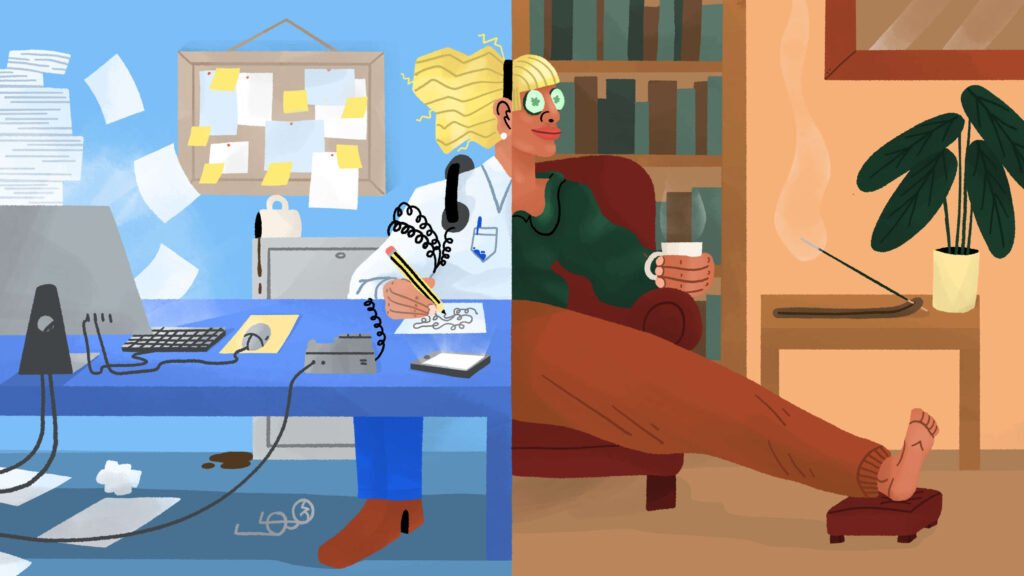When I first started out as a freelance journalist I was excited about going down a career path that allowed me the freedom to navigate my own timings and gave me more room to explore. I soon realised that getting that freedom was easier said than done. Living in Pakistan means I work in a timezone that is roughly 5 hours ahead of the UK, and anywhere between 9-12 hours ahead of the US, both of which are where the majority of my clients are often based. It also means that I end up scheduling zoom interviews for 10 or 11pm my time because that’s the earliest my interviewees can do on their end and often get responses from editors till late into the night. There was a time last year when I felt like I just could not switch off from work. Every email notification would make me start thinking about responses and assignments and bring me back into work mode all over again. It was only after experiencing burnout multiple times that I realised I needed to change the way I understood my work.
Workplace flexibility is often praised for allowing workers to develop a healthier work-life balance, and those benefits can be further increased by setting down established boundaries. These boundaries can often be different for every individual and understanding them can be key to healthy mental health and keeping work away from your personal time. While many of us assume that a 9-5 schedule is the norm, Karolina Cala, Head of Digital at Levitex Sleep, shares that she’s not a morning person at all, and the earliest she starts her day is around noon, but sometimes it can be 3pm as well – depending on her work schedule and other things planned around it. Understanding what hours you can be most productive at can go a long way in helping make the most of your work time, and not end up with you sitting in front of your laptop staring at the screen in a brain fog.
Of course that’s not the only step in creating work boundaries and regardless of start times switching off at the end can also take a toll if you don’t have set ways in which to end the work day. Freelance journalist Lola Méndez shares that although she works flexibly and tries to manage working between 10-15 hours a week, there’s times when she finds it hard to switch off as well.
“When I’m in the middle of a story I find it very hard to switch off. I can’t walk away until it’s done. It makes it harder when I have loose ends—if I didn’t finish prepping interview questions, sorting through research, etc. I approach each article as a puzzle and try to get one section done at a time so it feels manageable,” Mendez says. But despite that, she says that managing flexible working hours means she rarely has days where she’s stuck behind the screen the whole day.
To make the most of flexible hours, it’s often important to remind yourself that you are the boss of your own time, because not having a set time off can make you feel this constant pressure to be available. Rebecca Lockwood, a Neuro-Linguistic Programming, Positive Psychology & Breakthrough Coach Trainer, finds that her work-life balance is constantly changing as she balances work with parenting two young kids. “Although technology is so brilliant, I was left at the end of a constant pinging of notifications that pushed me into action. This did leave me feeling that I was ‘on demand’ and lead to burn out or very little work life balance because it is all work and no balance,” Lockwood shares, adding, “It can be so easy to lose yourself in work and not realise the time, or notice an email on your phone and get dragged back into work when doing things with family. Instead I set myself a cut off point. Times when I would stop working and focus purely on the family, or even on housework etc.”
For Cala, working in a room that is designated specially for her work, and shutting her laptop off at the end of the day create symbolic gestures that allow her to signal to her mind that work time is over. “I do this big theatrical thing where I shut off my laptop and once I’ve done that it’s not very often I’ll open that again. Once it’s shut off, it’s shut off and it stays in another room,” she says.
Lockwood also recommends that removing yourself from technology is extremely important in switching off from work mode.
“If you use your phone to read a book, or to communicate with family on an evening then silence your notification apps – such as emails, social media, work related apps etc. Even better, you can delete the apps altogether and while you are still tempted to pick up your phone you won’t have work notifications or apps to look through. If possible separate work and personal phones so that when you are working you use your work phone and when you are not working or away on holiday you can leave it in the office and use your personal phone,” she advises on ways to limit the constant access to work communication and fighting the pressure of staying ‘on.’
She also adds that it’s important to ask yourself what the purpose behind work tasks or goals is, sharing that it can allow for more mindfulness with the tasks and actions we take on. For Mendez, this means taking on assignments that she feels are worth her time and effort. “Only accepting work that pays within my pay scale allows me to have a work-life balance. I have a long morning routine that includes many wellness practices such as tongue scraping, oil pulling, meditating, and yoga. When I’m working, I am not on my phone or on social media. This helps me work better and work less,” she says.
In a world where people pride themselves on hustling, finding ways to prioritise yourself is rare and it’s far too easy to get caught up in this race of productivity and working harder. But it’s important to remember to slow down, really try to understand who you’re doing this for and put yourself first.




